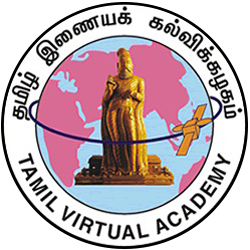Primary tabs
-
LESSON - 1
p20341 Drama - An Introduction
This lesson offers a brief introduction to Tamil drama.
There are several theories regarding the origin of drama. It is
believed that man’s playful nature coupled with a desire to
imitate others led to the rise of drama. Certain others believe
that drama may have either originated from dance or religious
rituals. Paavaanar, a renowned Tamil philologist, says that
the word ‘nadagam’ which signifies drama in Tamil must have
originated from the word ‘nadam’ which means dance. The
earliest dramas were enacted in ancient Egypt nearly 3000
years before the birth of Christ. Though Egypt is regarded
as the first home of dramatic literature, it was Greece where
the art of drama flourished. The ancient Greek plays exerted
a significant influence on the growth of drama around the
world.
Drama in India dates back to the vedic period. ‘Natya
Sastra’ written by sage Bharata is considered to be the
authoritative text on ancient Indian drama. Renowned Sanskrit
playwrights like Bhasa, Shudraka and Kalidasa shaped Indian
drama.
The origin of Tamil drama is closely associated with
religious rituals and dance. Stone inscriptions found in temples
and ancient literary texts offer an insight into the history of
Tamil drama. There is a reference to the term ‘nadagam’ -
or drama in ‘Tholkappiam’, the ancient grammar text.
Tholkappiam also alludes to ‘koothu’ performances.
Commentaries on ancient texts written by various authors
reveal that nearly 12 treatises on drama were written around
the period of Tholkappiar. Of these only 2 are available
today. They are ‘Kootha Nool’ and ‘Pancha Marabu’.
Literature of the sangam period also abounds in
references to drama. We learn about the lives of itinerant
performers called ‘porunar’ or ‘koothar’ who nurtured the art
of drama. Many of the poems in ‘Agananuru’, ‘Kurunthogai’
and ‘Nattrinai’ are in the form of dramatic monologues or
dialogues found in dramas. The reference to ‘velan veriyattu’
in sangam literature throws light on the ritualistic origin of
Tamil drama. ‘Thirukkural’, ‘Silapathigaram’ and ‘Manimekalai’
which are the most important texts of the post sangam
period also contain valuable information on the art of drama.
The epics ‘Perungathai’ and ‘Seevagasinthamani’ speak of
drama as an important art form and also detail the lives of
the performers. Sekeezhar’s ‘Periyapuranam’ offers a number
of interesting facts on drama.
Stone inscriptions belonging to the 10th century A.D. tell us
a lot about plays and the artists who performed them. Stone
inscriptions dating back to the period of the Chozha Kings
Rajenran I and Rajendran II are also a rich source of
information on the art of drama.



